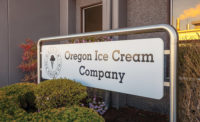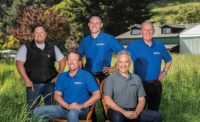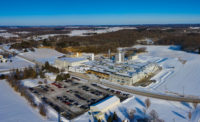Rumiano Cheese Co.’s plant closes the loop
Rumiano Cheese Co.’s plant strives to ensure nothing is wasted in its cheese-making process.










Idyllic Crescent City, Calif., is known for being the gateway to Redwood National and State Parks, where some of the oldest trees in the United States live. But the small town, which hugs the Pacific Ocean right by the Oregon border, has another claim to fame. It is home to Rumiano Cheese Co.’s plant, which produces award-winning organic and conventional cheeses, along with whey protein concentrate (WPC-80%), dried edible lactose and European-style butter.
Rumiano Cheese bought the now 25,000-square-foot plant in a period of company expansion during World War II (see the Processor Profile). After the military no longer required processed cheese production, Rumiano Cheese closed several facilities, but held on to its Crescent City plant (along with one other in Willows, Calif., where the company is headquartered and also runs its packaging operations). Today, it remains one of the town’s largest employers.
It’s all in the milk
According to Joby Rumiano, co-owner and administration manager, the rationale for keeping the Crescent City plant was its access to high-quality milk from grass-fed cows, which is the hallmark of Rumiano Cheese’s products. The town’s temperate climate allows cows to have almost year-round access to pasture.
“We [are] able to pull our milk from small, local family farms, with the furthest being 100 miles south and the closest being 12 miles to the north,” he said. “So we’re able to get very high-quality fresh milk that we can make cheese with in a short amount of time, so the milk doesn’t have to travel a long distance. We also can process it the same day we receive it.”
The plant’s operations begin at midnight, when milk starts to come in from the 27 dairies contracted by Rumiano Cheese. Kirk Olesen, chief of operations, said this is the first critical control point. When milk trucks arrive to the facility, a state-licensed operator performs a test to check for antibiotics in the milk. Each dairy is given a number, he said, which corresponds with a specific milk truck. This allows for full traceability.
“Everything flows like a river here at the plant,” Joby Rumiano said. “Once the milk starts, all the other processes follow.”
After the milk is received, Olesen said it goes into one of five silos based on whether it is organic or conventional. The milk is stored at 40 degrees Fahrenheit before it is pumped into a pasteurizer, where it is heated at 161 degrees Fahrenheit for 16 seconds. From there, the milk goes into a separator, which separates out the fat components (which will later be used to make butter).
Cheese is born
Next, the milk travels into one of three 40,000-pound cheese vats and is cooled to 90 degrees Fahrenheit. It’s here where enzymes and coagulants are added to turn the milk into cheese. At the time of Dairy Foods’ visit, the plant was producing organic cheddar cheese.
According to Olesen, casein forms together in the vat and makes cheese. It sets in 20 minutes, at which point a double agitator is used: One direction cuts the curd, the other direction stirs. This process requires 10 minutes, during which time the product is cooked from 90 degrees Farenheit to 104.
“And then from that point, you have curds and whey,” explained Joby Rumiano.
The product is pumped on to one of three drain tables to separate the liquids from the solids. The whey is drained off and put into a tank. It’s later used to produce Rumiano’s WPC.
While the curds are on the drying table, employees check for pH and moisture content levels of the curd and then salt once in specification, Olesen said. Once the moisture content looks right, the curds are pumped into a 22-foot-tall block former. They are squeezed through the tower and cut into 42.5-pound blocks at the bottom by a guillotine.
“At this point, it’s still curdy and soft,” Olesen said of the blocks, explaining that they go through a huge transformation in the aging process.
The blocks are put into polybags, which go down a conveyer to be vacuum-sealed. The blocks then go through a metal detector and leave the main manufacturing room, entering the packaging area. The blocks are weighed and hand-packed into a corrugated liner in a box.
“And then we’ll palletize it, and then it will go into the cooler,” said Joby Rumiano.
The cheese is transported to the Willows facility the day after production for slicing, cutting and packaging.
The Crescent City plant has a small storage cooler: It can hold only three truckloads (at 40,000 pounds per truckload) at a time. So the cheese is quickly moved to Willows for cutting, slicing and packaging.
The specialty aged cheeses take a slightly different journey. They are brought to the back of the cooler room to be brined. The hand-rolled 13-pound cheeses require a day per pound to brine. They’ll end up dipping down to 9 or 10 pounds as a result of losing moisture in the brine, Joby Rumiano explained. These cheeses will also be brought to the Willows facility, but to be aged in the cheese caves located there.
Waste not
Cheese production leads to a lot of byproducts, from whey to lactose to wastewater. And Rumiano Cheese either monetizes or recycles these components.
The separated whey goes through a spray dryer to create WPC. It’s unique for a company to run whey the same day as it makes cheese, Joby Rumiano said.
“We don’t allow a lot of time for bacteria to develop. And we don’t have to treat it with chemicals for pH balancing,” he explained. “So then we’ll run our protein, which is a really pure protein, no additives to it.”
Rumiano Cheese further uses its byproducts by recycling its water so it can use it again in the plant. After creating the WPC, Joby Rumiano said the company takes the leftover permeate and puts it through a reverse osmosis process. The water is removed from the permeate to be using in cleaning. Meanwhile, the lactose goes into the lactose drying facility. It’s turned into dried edible lactose, which is mainly used in formula.
“We are now utilizing nearly every component of milk coming into the plant and are creating water as a byproduct, which can be used in our CIP [clean-in-place] rinses,” Joby Rumiano said.
Olesen added that the water is mainly used for rinses and floors.
Some water even goes back to the city. In 2005, Rumiano Cheese got a grant to create a wastewater treatment plant to help it deal with excess waste, Baird Rumiano, the company’s co-owner and president, said.
To create the state-of-the-art wastewater treatment plant, both Crescent City and Rumiano Cheese put down $750,000. The treatment plant has the unique distinction of combining Oklahoman and Norwegian technology. A team came in from Oklahoma to do the initial design, but further ideas developed after Olesen visited the Norwegian foreign exchange student who had previously lived with him.
“When he went over to visit in Norway, he saw these big fiberglass silos over there, which were indoors
so they wouldn’t freeze,” Joby Rumiano said. “They could treat their sewage waste over in Norway by doing that.”
Olesen brought back the silo idea and Rumiano Cheese decided to implement it. The plant currently treats 20,000 gallons of cheese production wash water a day. This has decreased the company’s solid loadings to the city by 99% and allowed Crescent City to add 1,500 water and sewer hookups.
So the company’s initial investment has paid dividends in the local community, Baird Rumiano said. The wastewater treatment plant has generated millions in revenue to the local economy.
Joby Rumiano said the wastewater plant has gained a bit of a reputation. People from all over the world and all different industries have come to see how Rumiano accomplished its wastewater treatment goals.
“Even after 15 years … when I do a tour with the mega-companies that come out, they’re just like, ‘Holy cow, this is amazing,’” he said.
Sustainability initiatives
Beyond finding ways to use all milk components, Rumiano Cheese strives to be sustainable in other aspects of its cheese production. One way it does this is through water recirculation pumps, Joby Rumiano said.
The plant runs vacuum pumps 12 hours per day, six days a week, as a cooling mechanism. But to lower the amount of water used daily, the company installed first-of-their-kind water recirculation reservoirs, which reduce demand by millions of gallons a year. The recirculation also occurs on vats and boilers, which take the condensation from steam created while cooking cheese and reintroduce it back into the steam line to be used again for heating.
The plant is currently trying to achieve a zero-waste target, Joby Rumiano added. It is working toward that goal by recycling water, cardboard, plastic and wood, and reducing its paper usage by going digital.
Plant improvements
Rumiano Cheese is always making improvements to its facility and production process at the plant, Joby Rumiano said. In January 2011, Rumiano Cheese finished building its WPC-80% plant to utilize the protein out of its whey stream. Other recent additions include installing a new butter line (2012), new boilers (2014), a dried edible lactose facility (2015) and a new vacuum-sealing machine (2016).
“We are always trying to upgrade, trying to stay with the industry, trying to keep in the know,” said Baird Rumiano.
In 2010, the company installed a near infrared mass spectrometer in its on-site lab to help monitor its cheese-making process. According to Joby Rumiano, Rumiano Cheese was one of the first companies in the West to use this technology. It’s commonly used to test powders, but Rumiano Cheese wanted to see if it could also be used to test cheeses.
The spectrometer takes about 5 seconds to perform a test on a sample of cheese, looking at its butterfat content, salt, moisture and pH level, Olesen explained. The data are then plotted on a graph that compares them to the historical data from identical varietal cheese samples. This way, Rumiano Cheese can identify outlier samples and make changes to the cheeses during production to ensure they’re at the correct levels.
“It does a linear regression analysis, so you need the statistics,” said Joby Rumiano. “I think we’re right at 98% confidence now on our products. But it takes a long time to get enough data set in there.”
The most recent investment Rumiano Cheese made in its plant was in 2019, when it installed a scale and inventory-tracking software. According to Joe Baird, CEO, the company decided to invest in this software to ensure that “from the minute the milk enters the vat and the cheese is made, all the way through to wherever eventually that block of cheese is, we know where that it is [from].”
This total transparency and traceability allow Rumiano Cheese to figure out where any cheese production problems originated, and how to fix them in the future.
“When I receive a phone call or email from a customer commenting about a specific dairy product, good or bad, we now have the ability to trace back through the production to the dairy farm, and in some cases the cow,” Baird Rumiano said.
The company would like to expand further in Crescent City, but because of the small size of the town and its proximity to the ocean, there is a limited amount of land with which to work. However, the company is looking into expanding its refrigerated storage area.
“We have started the procedure,” said Baird Rumiano. “We have accumulated some property that is next door here in the hopes of building a big refrigerated storage facility here, because our little, tiny icebox only holds about two days’ worth of cheese.”
Looking for a reprint of this article?
From high-res PDFs to custom plaques, order your copy today!











